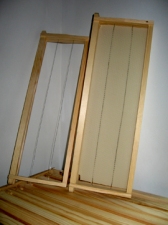A lot of beekeeping at Brookfield Farm is fun. However, I would not put making frames, wiring them, and hanging wax into that category. It falls under “must be done” and “oh, I can listen to these podcasts I collected.”
I put the frames together with a pneumatic stapler hooked to an air compressor, using a Kelley Bees frame nailing device (that’s what it’s called). That’s all pretty normal. I put staple through each end of the top bar and bottom bar, then 2 more staples: one under each “arm” of the top bar, going though the side and into the top bars.
I put the wax on the wire by using a Kelley’s Electric Embedder tool as well: a bar that puts a current though the wires, which heats them up and the wax melts to the wires.
The way I wire my frames is a bit different from most beekeepers I know.
First, it must be said that I do everything in westerns. So my frames have only two lines of wires that cross them.
Here’s what I do:
Pull off a long piece of wire and thread it into the frame.
Loop it though on the other side:
Give the wires a bit of a tug and grasp the ends with thumb and finger and spin the frame.
The wires tighten up, but not quite enough
Snip the extra wire beyond the “twist”, and then twist that wire down.
Holding the twisted side with my finger, I give a bend to the wire on the other side.
That makes the wire tight.
This holds perfectly well. As one beekeeper said to me : “the wire doesn’t hold the wax in place, it keeps it from sagging”. Made sense to me.
I used to wire frames by using nails to hold the wire and stretching the frame a bit as I wired.
The way I do it now moves things along much faster for me. Plus it works equally well.
I must admit that the next time I order frames, I think I’ll look into ready-made wooden western frames. At least that will take part of workload away. That could be a while though, I got a bit carried away last year and ordered an amazing number of frames (I can’t even remember now how many), and I’m still working though all those.
So the week hasn’t been exactly action packed, but I did get to be inside during all the rain.That’s the news from Brookfield Farm Bees And Honey in Maple Falls, Washington.
Do you have innovative ways of making frames, wiring, or hanging wax? Do share.
















Karen, have you ever run foundationless? If so I would really like to hear about how that went for you!
Regards,
Janet
Hi Janet – I tried that one year. It didn’t work out well. The bees worked everything but the foundationless…except for one “just put it in” moment. I was frustrated with no action in my perfectly level hive where I was trying foundationless beekeeping, following all the on-line directions. So I picked up an unworked frame, and plopped it into a hive with foundation and drawn comb. Putting it between 2 drawn combs. It came out perfect. I really should try this again with : drawn, foundationless, drawn, foundationless… and so on. By the way the hive it was plopped into was far from level – canted at 2 angles… The one thing I would suggest is WIRE the foundationless frame. It didn’t even get to the extractor, it broke on the way….Had it been wired, I think it would have held. If you can do foundationless, it’s great. Most healthy, and saves tons of money, and no darned if you do and darned if you don’t plastic or wax foundation issues.
Pingback: Bee Hive Foundation : So Many Foundations So Little Time | Brookfield Farm Bees & Honey Blog
I think any honey being harvested from foundationless frames should just be taken with the wax, plop it in a jar, call it 100% natural and charge more per jar. Then you get new wax every year.
That’s brilliant – best idea I’ve heard.
Pingback: Harvesting Honey, Treating Hives | Brookfield Farm Bees & Honey Blog
Pingback: Bee Year 2015 Overview – Brookfield Farm | Brookfield Farm Bees & Honey Blog